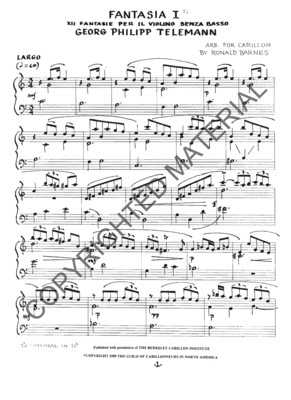
[PDF] XII Fantasie per il violin senza basso
Program notes
The ease with which music composed for unaccompanied bowed stringed instruments may be transferred to the carillon frequently tempts carillonists to play it, verbatim, from the original score as though they were committing an act of musicological purity. The solo violin music written in the 17th and 18th centuries is especially alluring. Its tessitura so comfortably lies within the range of the carillon that it is usually not necessary to transpose the music out of its original key in order to accommodate it to the different medium. The simple texture seems especially suited to the carillon.
However, to transfer this music literally to the carillon denies to it the possibilities for realization that the less restricting carillon has to offer. The physical capabilities of the violin, like any other instrument, impose limitations on the composer and largely determine the nature of music written for it. Even though this music is naturally monophonic, it is possible to play two simultaneous tones, and if broken or arpeggiated, four-note chords. Such an intriguing capability has naturally led composers, who were also accomplished violinists, to push the instrument to its utmost limit by writing three and even four-voiced fugues for a single violin.
The music written for violin alone, especially if it is polyphonic, is necessarily an abstraction, or perhaps more accurately, a contraction of what a composer might write for a less restrictive instrument. Often those passages, which appear to be purely monophonic, include notes which, if played on another instrument with greater capabilities, would be emphasized or sustained in order to more adequately provide harmonic support to the actual melodic line. The violinist is able only to acknowledge the purpose of these notes by rhythmic accentuation rather than by sustaining them. Such subtleties can be (and usually are) lost on an audience who, unlike the performer, is most likely unaware of them. However, when played on the carillon it is almost as though this music is freed from its restrictions.
Notes on which the violin can only hint at their actual purpose are naturally sustained on the carillon. And with its greater downward range, the carillon offers the sounding of bass notes to support and strengthen harmonic progressions and key changes, a support which is merely implied in the violin score. Narrow intervals and chords may be opened up to contain a richer and, on the carillon, less dissonant sonority, and notes which can only be sustained so long as the bow is being drawn across a string sustain themselves while the performer moves ahead to play the rest of the notes in a passage, actually enhancing its clarity.
This realization of the potential of the original violin score is the process which most concerned me in arranging Telemann's Fantasies for carillon performance. My chief aim was to preserve the composer's original concept, but at the same time to translate his music, without obscuring it, into viable and idiomatic music for the carillon.
Before I had completed the preliminary work on my realization of the Telemann Fantasies, I decided to dedicate the entire set of twelve to Albert Gerken, distinguished carillonist at the University of Kansas. I sent a copy of these first editions to Professor Gerken, asking him for his candid criticism and for suggestions on how they might be improved. He responded with enthusiasm and in detail on every aspect of what I had done to make carillon music incorporated into the final version.
Albert Gerken's contributions to the completion of this project are more than sufficient to qualify it as a joint effort. For me this collaboration has been not only instructive and rewarding, but eminently successful.
—Ronald Barnes; San Francisco, California; 1989
![[PDF] XII Fantasie per il violin senza basso [PDF] XII Fantasie per il violin senza basso](https://d2j6dbq0eux0bg.cloudfront.net/images/9481258/983392404.jpg)
